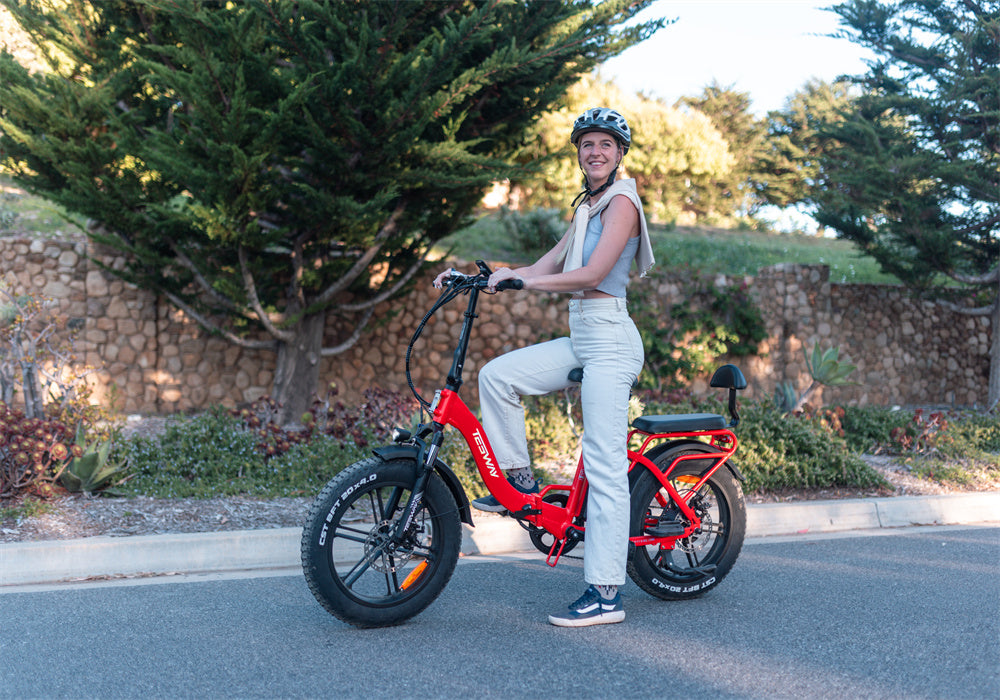Electric bikes have revolutionized urban transportation, with their sales increasing by 240% in the United States from 2022 to 2023. Their ability to combine the benefits of traditional cycling with the added power of an electric motor makes them an appealing choice for many.
Electric bicycles come with specific weight limits. These weight limits, which range between 220 and 350 pounds depending on the model, are crucial for ensuring safety, performance, and durability.
All Bikes Have Weight Limits
Charles, an experienced electric bike rider. He encountered multiple issues when exceeding weight recommendations on various bikes which have be upgraded, such as broken spokes and cracked frames.
On a bike, Charles had to upgrade to wider rims and 48 spokes to support a higher weight.
Despite these upgrades, the bike still faced problems with breaking spokes and front suspension issues due to excessive weight and higher speeds.
Charles also experimented with tires, using larger Maxxis Hookworm tires at 100 psi, which allowed a load limit of 400 lbs.
However, even with these robust tires, the structural integrity of the bike was compromised under the additional weight.
He noted that when bikes are pushed to their load limits, critical components like wheels, spokes, and frames are prone to failure.

Current Weight Limits for Electric Bicycles
Current ebike weight limits typically range between 220 to 350 pounds, depending on the make and model.
Different Materials and Constructions Affect Electric Bike Weight Limits
The material and construction of an electric bike frame are critical in determining its weight limit.
Aluminum Frames
These are popular due to their lightweight and corrosion-resistant properties. Aluminum frames can support moderate weight limits (typically up to 250 lbs). They offer a good balance of strength and weight but can be prone to fatigue over time, especially under high loads.
Steel Frames
Known for their durability and strength, steel frames can handle higher weight limits, often exceeding 300 lbs.
Steel is less likely to suffer from fatigue and can withstand greater stresses, making it ideal for heavy-duty and cargo electric bicycle.
However, steel frames are heavier, which can affect the bike's overall performance and efficiency.
Carbon Fiber Frames
These provide an excellent strength-to-weight ratio, making them suitable for performance-oriented ebikes.
Carbon fiber frames are lightweight yet strong, supporting weight limits similar to aluminum or slightly higher. They are, however, more expensive and can be vulnerable to impact damage.
Titanium Frames
Titanium offers a combination of light weight and high strength, similar to carbon fiber but with better durability.
Titanium frames can support high weight limits and provide a comfortable ride due to their natural flex. They are also resistant to corrosion, but the high cost makes them less common.
The construction method also plays a significant role. Frames with reinforced joints, thicker tubing, and additional support structures can handle higher weights more effectively.
Manufacturers use various techniques such as hydroforming (for shaping aluminum frames) or welding (for steel and titanium frames) to enhance the structural integrity of electric bike frames.
Can a 300 lb Person Ride an Electric Bicycle
Yes, but it is essential to choose an electric bike designed to handle higher weight limits. Below is a table detailing appropriate electric bike choices based on rider weight:
|
Rider Weight |
Electric Bike Type |
Recommended Load Capacity |
|---|---|---|
|
150-200 lbs |
Standard |
220-250 lbs |
|
200-250 lbs |
Heavy-Duty |
250-300 lbs |
|
250-300 lbs |
Extra Heavy-Duty |
300-350 lbs |
|
300-350 lbs |
Fat Tire |
350-400 lbs |
-
Manufacturers specify these limits based on rigorous testing and engineering principles. The weight limits include not just the rider's weight but also any additional load such as cargo or accessories.
Factors Affecting Electric Bike Load-Bearing Capacity
Frame Material and Design
The material of the electric bicycle frame significantly affects its strength and durability. Aluminum frames are common for their light weight and corrosion resistance, while steel frames offer higher strength but are heavier.
Carbon fiber frames provide excellent strength-to-weight ratios but can be expensive and more susceptible to impact damage.
Wheel Size and Spoke Count
Larger wheels and a higher spoke count can distribute weight more effectively, reducing the risk of damage under heavy loads.
Wheels with 48 spokes are stronger and better suited for heavier riders than those with fewer spokes.
Tire Type and Pressure
Wider tires with higher air volume can support more weight and provide better stability.
Proper tire pressure is crucial for maintaining this load-bearing capacity.
Suspension System
An ebike's suspension system, including front forks and rear shocks, can absorb impacts and distribute weight more evenly.
Robust suspension components are essential for handling heavier loads without compromising ride quality.
Here is a table showcasing the maximum load-bearing capacity of different types of ebikes:
|
E-Bike Type |
Maximum Load Capacity |
|---|---|
|
Standard |
220-250 lbs |
|
Heavy-Duty |
250-300 lbs |
|
Fat Tire |
350-400 lbs |
|
Folding |
200-250 lbs |
|
Mountain |
250-300 lbs |
Best ElectricBike for Big and Tall
For those who are on the heavier side, selecting the right ebike is crucial. The TESWAY S7 fat tire ebike stands out as an excellent choice, offering a maximum load-bearing capacity of 350 lbs.
This bike is engineered with a robust frame, wider tires for better stability, and a powerful motor to ensure a smooth ride even at higher weights.
Why Choose TESWAY S7?
Durability: The TESWAY S7 is built with high-quality materials that withstand greater stress and strain, ensuring longevity and reliability.
Comfort: The fat tires provide better shock absorption, making rides more comfortable on various terrains.
Performance: Equipped with am 750w powerful motor, this ebike ensures efficient performance without compromising speed or range.
Ensuring Safety and Longevity of Your Electric Bike
Overloading an ebike can lead to premature wear and tear, damage to components, and potential safety hazards. Regular maintenance, such as checking tire pressure, inspecting brakes, and ensuring the frame is in good condition, will help keep your ebike in optimal shape.
Impact of Overloading on Electric Bikes
Structural Damage
Overloading can cause frames to crack or break, especially at weak points like the seat post or the junctions of the frame.
Component Failure
Wheels, spokes, and tires are particularly vulnerable when an electric bike is overloaded. These parts can bend, break, or fail completely.
Reduced Performance
An overloaded electric bike may struggle to reach its maximum speed or range, and the motor may overheat, reducing its lifespan.
Safety Risks
Overloading can lead to instability, making the electric bicycle harder to control and increasing the risk of accidents.
Conclusion
The TESWAY S7 fat tire electric bike is a prime example of a high-capacity e-bike designed to accommodate heavier riders, offering both performance and comfort.
FAQs
Do overweight riders need special insurance for their e-bikes?
While standard e-bike insurance should suffice, overweight riders might want to ensure their policy covers any specific customizations or higher weight capacities to avoid any potential issues.
How can overweight riders improve their balance on e-bikes?
Overweight riders can improve balance by practicing on flat, open areas, starting with lower speeds, and gradually increasing their comfort level. Properly adjusting the seat and handlebars can also enhance stability.
What are some common issues overweight riders face with e-bikes, and how can they be addressed?
Common issues include reduced battery range, faster wear and tear, and handling difficulties. These can be addressed by choosing e-bikes with high-capacity batteries, durable components, and ensuring regular maintenance.







Share:
Can Higher-Weight People Ride Electric Bikes
2024 Best Electric Bikes for Big Guys —— Quality bikes at an affordable price point